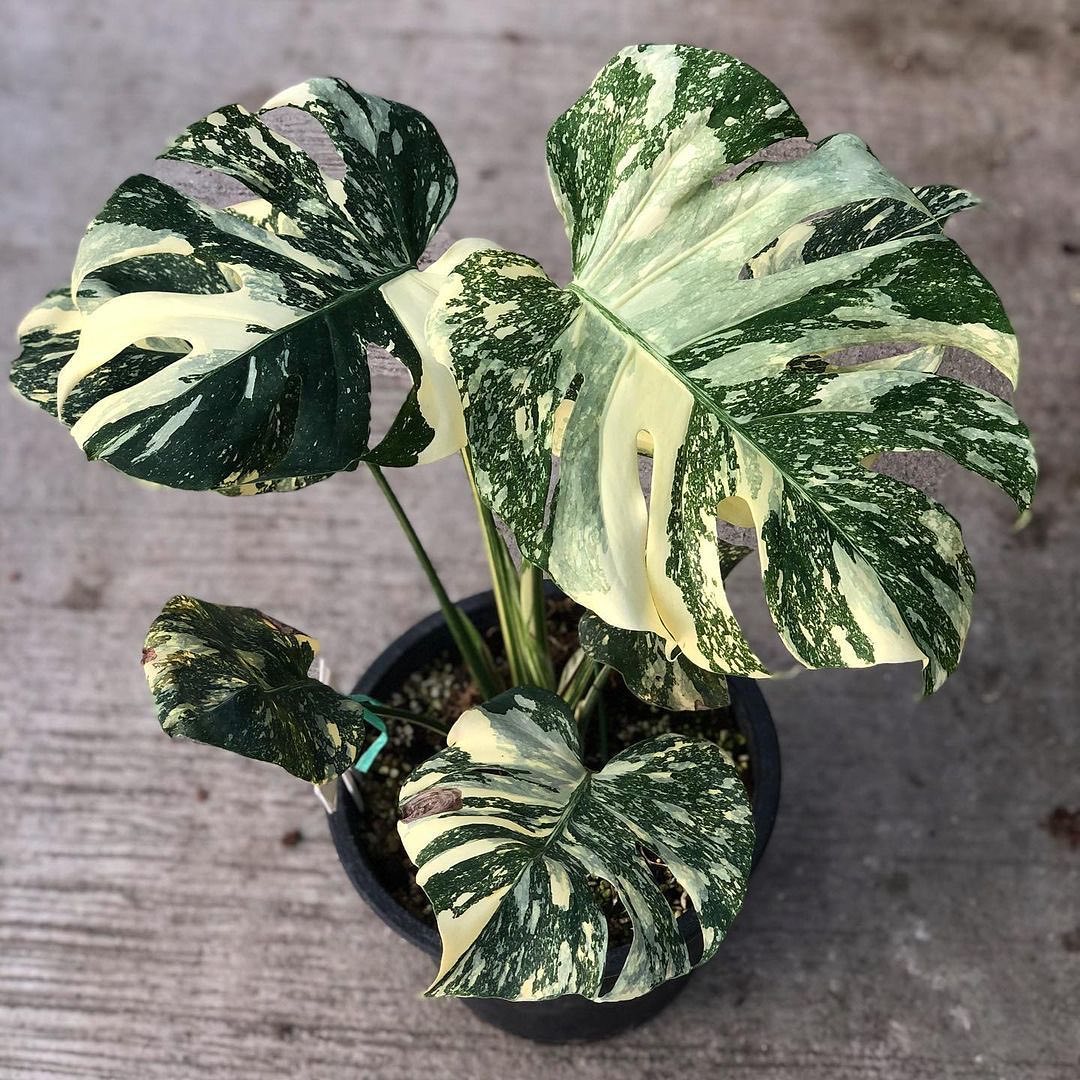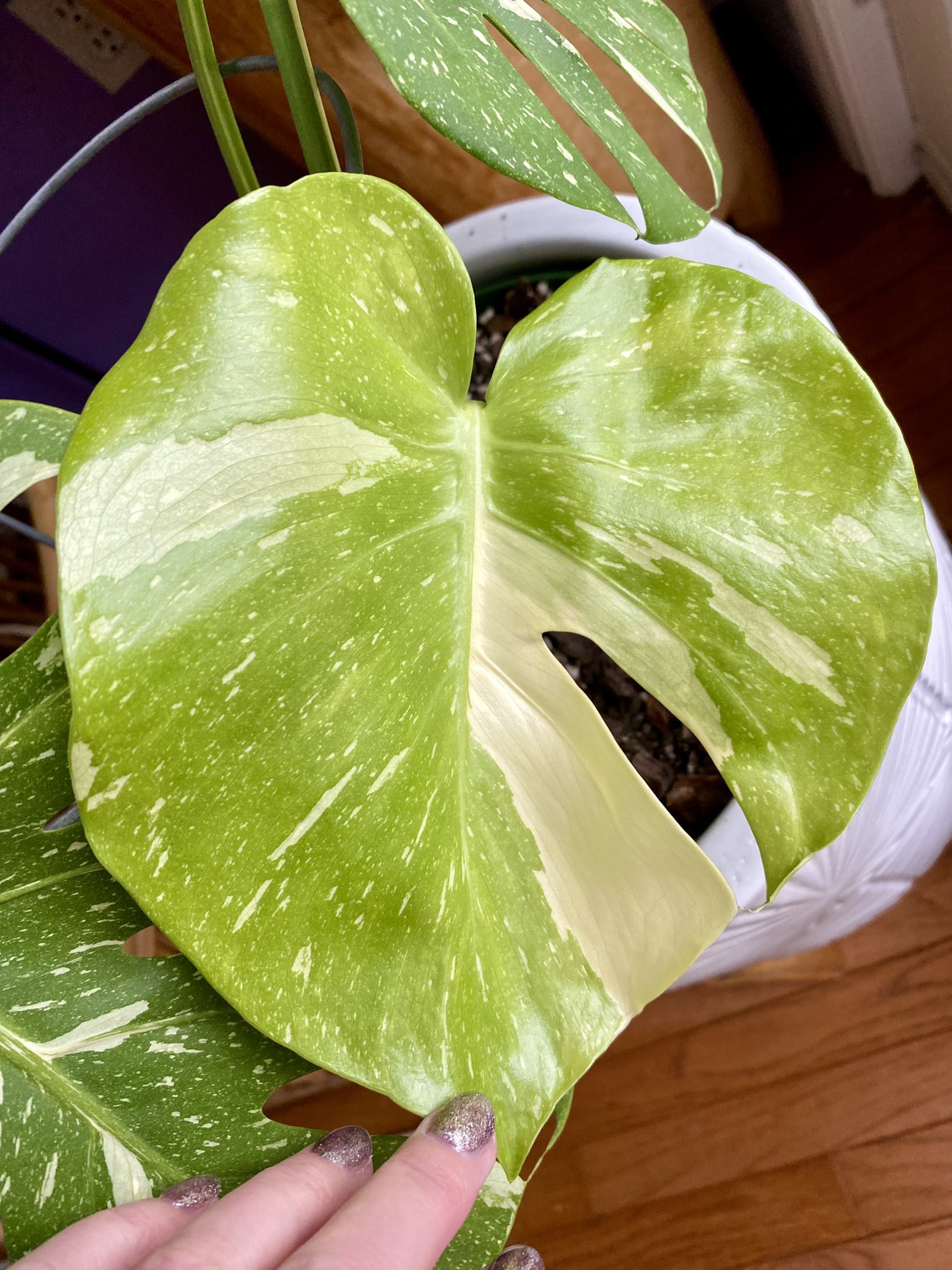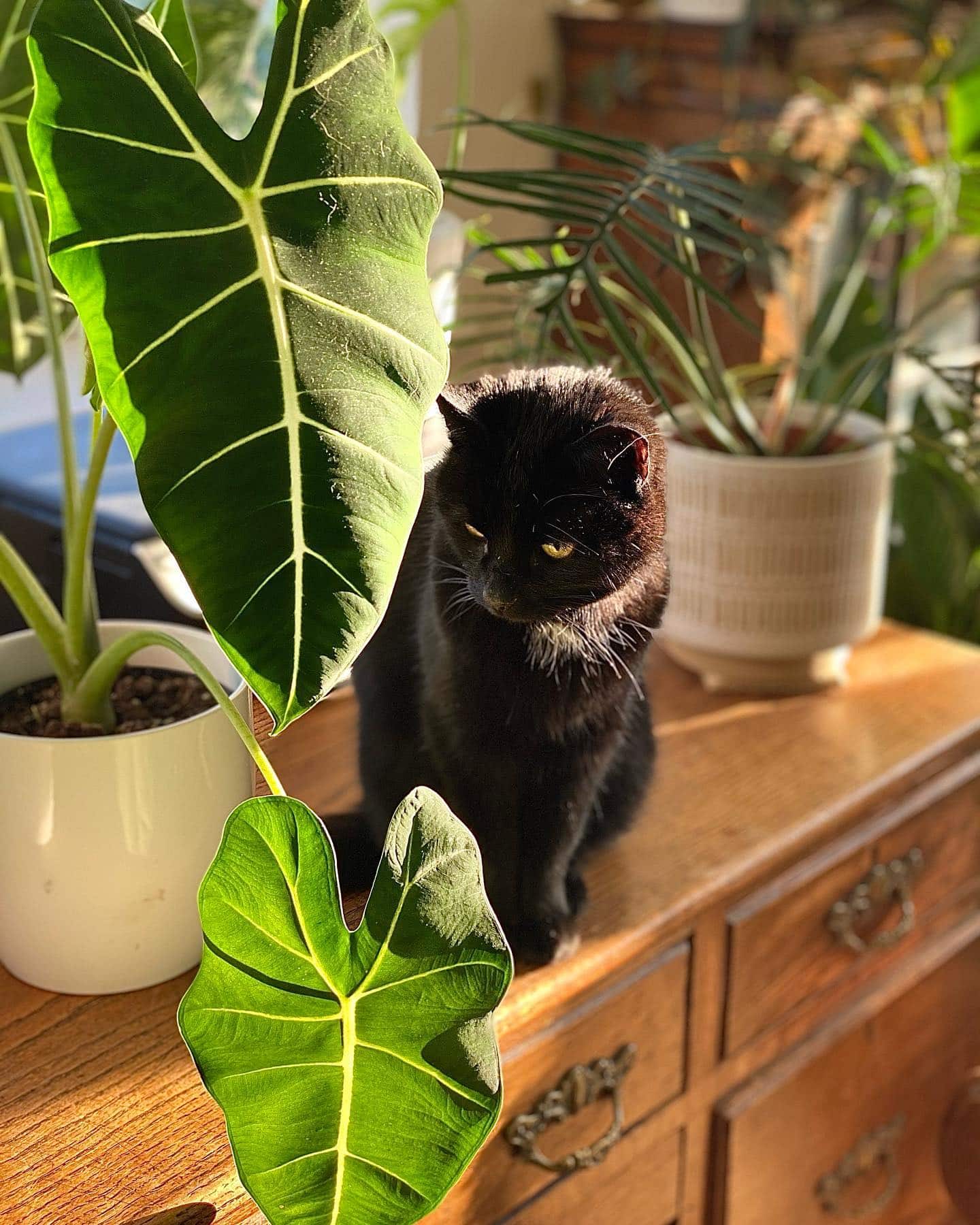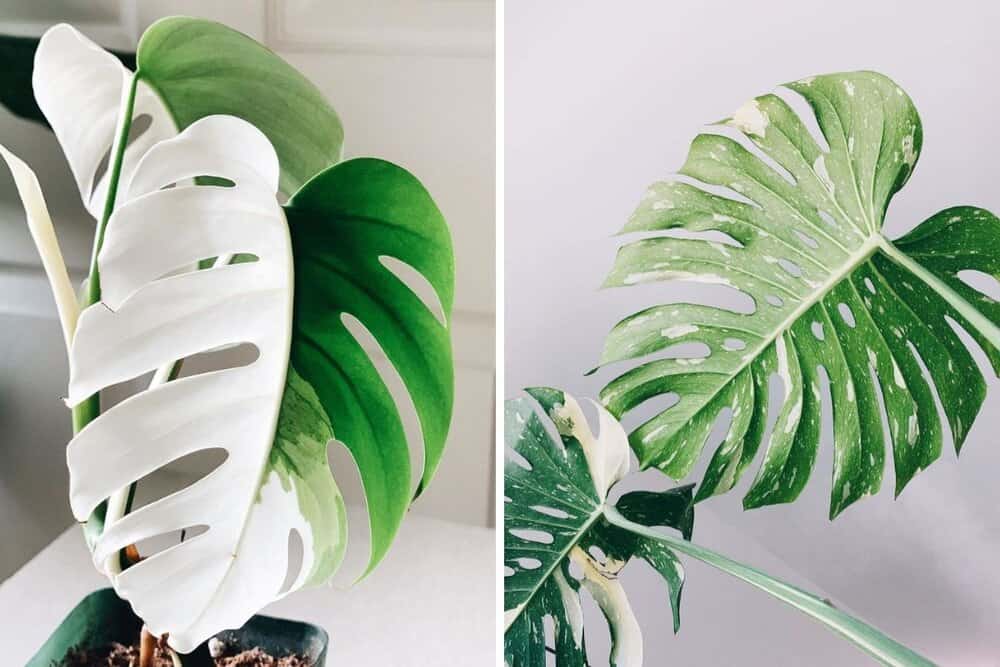When you overwater your Monstera Thai Constellation and keep it in a damp or cold place, fungal infections or diseases may occur.
Continue this article to know how to best care for your Monstera Thai Constellation without suffering.
Table of Contents Show
Overview of Monstera Thai Constellation
Monstera Thai Constellation is a tropical plant native to Southern Mexico and Panama.
Thai constellation is a particular cultivar of the classic Monstera deliciosa with typical dark green leaves with a speckled and splashed texture with white and cream.

Here is a brief overview of this plant.
| Scientific Name | Monstera Deliciosa 'Thai Constellation', |
| Other Names | Swiss Cheese Plant, Monstera Thai, Thai Constellation, Split-Leaf Philodendron |
| Native | Variegated Swiss cheese Vine, Variegated Cheese Plant and Variegated Salad Plant |
| Family | Araceae |
| Genus | Monstera |
| Growth Zones | USDA zones 10b-12 |
| Plant Type | Evergreen Perennial |
| Growth Rate | Slow growth |
| Growth Size | Up to 8 feet in length and 3-12 inches in width |
| Foliage | Cream and green leathery split leaves |
| Blooming Period | Spring and Summer |
| Flowering and Fruits | Spadix flower, Scaly edible fruit |
| Toxicity | Mildly toxic to humans, toxic to pets |
| Common Pests | Spider mites, white flies, soft scales, and mealy bugs |
| Horticultural Diseases | Powdery Mildew, Anthracnose, and Monstera Leaf Blight |
Monstera Thai Constellation for Sale
This beautiful Monstera Thai Constellation has a huge demand for indoor houseplants; you can expect these plants to range from $135 to $1,000 at prices.
If you need to get one for yourself, visit the following online nurseries.
| Places to Buy | Delivery Time |
|---|---|
| Etsy | 8-16 business days |
| Carnivero | 3-5 business days |
| Plant Buys | 3-7 business days |
| Amazon | 5-7 business days |
| Grow Jungle | 2-3 business days |
Monstera Thai Constellation Care Guide
The growth of Thai Constellation, in terms of height and new leaves or foliage, heavily depends on the quality of care it receives.
So, you need to mimic the tropical environment!
 6-8 hours of indirect bright sunlight |  Once a week in spring and summer Once in two weeks in fall and winter |
 Well-draining, nutrient-rich potting mix pH level: 5.0 to 7.5 |  Balanced all purpose fertilizer Once in spring and summer |
 64°F − 70°F |  60% and 80% of humidity |
 Once every 2 years in spring or early summer |  Propagate Stem Cuttings, plant separation and air layering |
1. Light & Temperature
Monstera Thai Constellation might survive under low light but cannot thrive well.
Leggy growth, a lack of split and holes with the loss of leaf variegation can result from insufficient light. And eventually, the plant stops growing below 50º F as Mosteras are prone to frost injuries.
That said, though Monstera loves warm temperatures, you should not leave your plant under 90 degrees Fahrenheit.
It will cause plants to dry up and wilt. Besides, the scorching sun can make the plant turn yellow and suffer from sunburn.
Tips to Maintain Ideal Light & Temperature
- Place the plant near the south or west-facing windows under bright indirect sunlight.
- Use a curtain to reduce the light intensity by 30% to 50%, which is safe for Mostera plants.
- You can also apply a grow light with the red-blue light spectrum instead of white.
- Also, you must remove the plants from the chill window during winter.
- You can also grow the plant in a greenhouse. Make sure you have enough heating capacity to grow the plant in winter.
2. Water & Humidity
Though Monstera is a tropical plant, avoid watering it frequently.
Meanwhile, excess soil and air moisture may lead to bacterial root rot, brown spots on leaves, mould growing on soil, oedema on the leaves, and wilting and curling.
Likewise, if you forget to water the plant, spots appear on the leaves, and the plant droops.

So, to maintain optimum moisture, bottom water the plant using rainwater or filtered water for Monstera and group it along with other house plants.
You can fill a tray with 1-inch pebbles and water halfway up the pebbles or place the plants in the bathroom or kitchen.
Avoid unfiltered or dirty water as it may cause the browning of tips and edges.
Further, you can use a humidifier to increase the humidity around your plant, or your plant may wilt and leaves turn crips and yellow with brown edges.
3. Soil & Fertilizer
Monstera is adaptive to a wide range of soil as long as it is well-draining with sufficient nutrients.
You can make DIY potting soil by mixing 1 part peat moss/coco coir, 1 part perlite, and 4 parts pine bark fines. Also, add some organic manure to support better growth.
Keep in mind that excessive feed can cause more harm to the plant than good. The chemical burn in the soil can cause root rot and leaf discoloration.
So, before randomly applying the fertilizers, have a look at the table for soil and fertilizer option suitable for Monsteras.
Tips for fertilizing Monstera
- Do not apply liquid fertilizer directly to dry soil. Only fertilize your Monstera after watering it and leaving it the whole night.
- Dilute the liquid fertilizer to 1/4 of the recommended strength and pour it directly onto your plant’s soil.
- Ensure the fertilizer does not directly touch flowers, fruits, leaves, or stems to avoid fertilizer burn.
Expert Tip! Combine potting soil with perlite and a few chunky pieces of bark or sphagnum moss to retain the excess moisture.
4. Potting & Repotting
Monstera Thai Constellation also needs repotting once every two years with 2 inches bigger pots in diameter unless they show the root bound sign.
Terracotta would be the best choice for the plant’s root, but concrete and plastic can also do the job. But the pot should be about 2 feet wide (60 cm) to support a stake or moss pole for the Monstera to climb.
- Choose a good pot according to the size of your plant. Prepare the required soil mix and get a moss pole.
- Cautiously remove the Monstera from its pot with gentle hands. Cut off aerial roots if they are extremely long or infected and turn the pot over and gently coax the roots.
- Check if the roots are too packed for this and dig a narrow, deep hole into inserting the pole if it has a similar condition.
- If you are repotting the Monstera with its old moss pole, hold the plant over the pot, firmly stake the pole into the pot, and narrow the roots down.
- Use rain or filtered water for watering. For once, water the plant until the water comes out of the drainage holes.
Pro Tip: Your plant may still appear droopy after repotting. Do not worry, as it shall start growing once it adjusts to the new home.
5. Regular Pruning
Monstera generally does not require much pruning, making it a low-maintenance plant.
Prune the plant annually, in spring or summer, and the plant is good to live for a long period.
Fungal diseases, including Powdery Mildew, Anthracnose, and Monstera Leaf Blight, also disturb plant growth.
First, try neem oil or dish soap to control the pests and disease spread. If the invasion does not subside, pruning becomes mandatory.
- Start by cutting diseased or dead plant parts first.
- Throw the cuttings away when you’re done. If not, Monstera can easily root in the ground.
- Do not prune too much or more than 1/3 of the plant to make the plant younger.
Monstera Thai Constellation: All About Growth Rate
Monstera Thai Constellation is a slow-growing climber that reaches maturity in about two years.
But indoor Mostera Thai Constellation can only grow up to 8 feet long (2.5M).
Regardless of the location, support the plant by using a moss pole or wooden or bamboo to stake the Monstera plant.
Foliage Profile
The plant has a signature shape of the paint strokes of Jackson Pollock on the leaves.
The leaves showcase a beautiful pattern of cream splotches against green to dark green leathery leaves. Further, the mature foliage usually is 18 inches or more.
Flower and Fruit
Monstera Thai Constellation produces a large white flower that rarely blooms throughout spring and summer.
Flowers are off-white in color, lightly scented, and non-showy, and the size of each flower is about 6 to 12 inches.

Moreover, these blossoms produce a fruit that looks like an ear of a cob covered with green hexagonal scales. It can reach up to 12 inches in length and 2 inches in width.
The fruit is edible and tastes like pineapple and jackfruit, but you should not consume the unripe fruit.
Toxicity of Monstera Thai Constellation
According to the ASPCA, Monsteras, in general, are toxic (level 3 to 4) to pets and humans, and Thai Constellation is no different.

You should immediately contact the nearby vet or the animal poison helpline.
- ASPCA Animal Poison Control Center, 888-426-4435
- Pet Poison Helpline, 855-764-7661
Propagation Methods for Monstera Thai Constellation
Monstera Thai Constellation has multiple ways to populate itself into an entire mini jungle.
Seeds can produce the plant, but variegated leaves will not come from the seeds.
They will still require parts of the stems of leaves to produce the same variegated coloring.
1. Propagation via Stem Cuttings
To continue propagating a Monstera Thai Constellation, you must identify stem cuttings with at least one leaf and a visible aerial root.
Cuttings need to be ½ an inch to an inch below the node. You can also propagate Monstera without a node.
- Select a mature, healthy stem node and cut right below a node with sterilized pruning shears.
- Remove all leaves except one or two.
- Dip the cut end in root growth hormone to stimulate plant growth.
- Fill the pot with potting mix, then plant the cutting with the node in the soil and lightly water them.
- Cover the cutting with a sealable plastic bag to preserve humidity. You can also poke a hole or two to facilitate respiration.
- Keep the pot under indirect bright sunlight and remove the bag after a week, and your plant will start rooting after 3 to 5 weeks.
- After the root grows over 3 inches, you can transfer the plant to another pot.
The steps in growing the plant in water are similar to soil propagation, but you dip your node in water. Do not cover the plant with a plastic bag, and make sure you change the water every few days.
You can transfer the plant to the soil after 4 to 6 weeks.
2. Propagation via Air Layering
This process does not require cutting nodes and propagating in any medium. For this, you will need peat moss.
- Take a healthy stem and make a small cut at the node with sterilized shears or a knife.
- Take some moss in your hand and wrap the cut with the moist peat moss, and seal it with a plastic bag.
- Make some holes in the bag to allow air circulation
- Mist the area regularly; after a few weeks, you can withdraw the plastic.
- When there is an outgrowth of roots, you can cut the new stem and plant it in a new pot.
3. Propagating via Plant Separation
Monstera Thai grows in dense, so separating the plant helps in keeping your plant a manageable size and apart from giving the free plants.
- Add water to the Monstera plant and let the soil dry.
- Gently transfer the Monstera plant from the planter into an open space.
- Grab a pair of scissors and cut the pot through the soil, and gently divide the roots into two or more new plants.
- Make sure you perform it without cutting any stems and leaves.
- Now take a new pot a few inches bigger than the root balls of each new plant.
- After that, you can plant the stem cuttings into a pot with rich soil.
- Now, place the young plants under the bright spot.
- And water the plants regularly according to the soil condition.
Monstera Thai Constellation Vs. Albo
The main difference between Albino Monstera and Thai Constellation is the variegation in the leaves.

Let’s look at the different features of Monstera Thai compared to Albo.
| Monstera Thai Constellation | Monstera Albo |
|---|---|
| Yellow variegation on leathery green leaves | White variegation on leathery green leaves |
| Consistent variegation. Almost all leaves show variegation. | Inconsistent variegation. Either half white-half green leaves or fully white or fully green leaves. |
| They grow wider instead of taller. | They grow taller instead of wider. |
| Leaves can easily reach 2 feet or more in length. | Leaves do not grow more than 12 inches long. |
| Short internodes, thus more bushy | Nodes are 6 inches apart, so the plants have an elongated look. |
| Easier to propagate | Harder to propagate |
FAQs about Monstera Thai Constellation
Does a Thai Constellation require a moss pole?
We recommend Moss poles, but they are not strictly required.
Moss pole does provide support to this climbing plant and may provide nutrients and moisture as well.
Why is Monstera Thai Constellation too expensive?
Monstera Thai is expensive because it is rare and highly popular with demand.
This species grows more slowly than any other standard Monstera Deliciosa and is more difficult to propagate. Thus, suppliers can run out of stock extremely fast.
From Editorial Team
Provide Adequate Space!
Growing Monstera does not require anything fancier than your average houseplant, but you might need adequate space as it grows a lot bigger.
If you already have a healthy plant collection, you will do great! You can easily grow Monstera as it is low maintenance.


